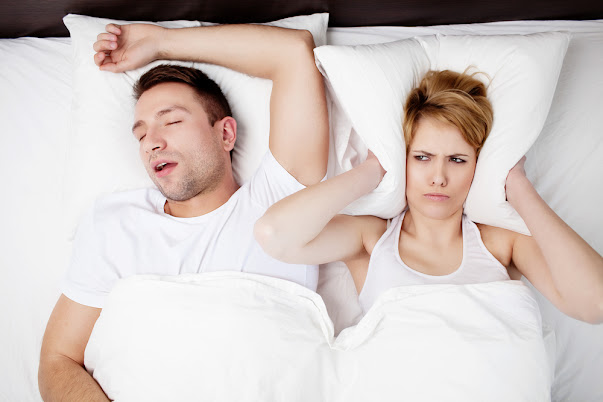Snoring is more than just a frustrating habit that makes your sleeping partners uncomfortable. This can also be an indication of something worse. Here are some essential facts you need to know about snoring and its association with sleep apnea.
Sleep apnea is a disorder which is characterized by abnormally shallow breathing (hypopneas) or abnormal pauses in breathing (apneas) during sleep. These apneas can occur due to a physical blockage to airflow or a lack of respiratory effort, or a combination of both.
Sleep apnea is a disorder which is characterized by abnormally shallow breathing (hypopneas) or abnormal pauses in breathing (apneas) during sleep. These apneas can occur due to a physical blockage to airflow or a lack of respiratory effort, or a combination of both.
Snoring: Snoring is due to relaxation in soft tissues (when breathing) around the back of the throat which causes the narrowing of the upper respiratory structures while sleeping. Meanwhile, anything that narrows the breathing passages can also cause snoring, which includes: Enlarged uvula, medically known as the Palatine uvula (fleshy piece of tissue that hangs down in the back of your throat), deviated septum (when the thin wall between your nostrils is misaligned), an elongated soft palate, obstructions in the nasal area and larger tonsils.
If you suffer from daytime fatigue and sleepiness, and/ or if you don't feel refreshed in the morning after a night's sleep, you should, perhaps, consider getting a sleep study. There are a few ways that you can get that done. The usual method is to go to a sleep study clinic (or a clinic which specializes in Sleep Apnea Snoring Treatment), where you will be connected to a variety of devices that will monitor your body functions while you are sleeping. These include brain activity, eye movements, heart rhythm, oxygen saturation, and muscle activity. Another option is you can get a home testing device, which will also monitor your certain sleep functions, but in the comfort of your own home and bed.
Symptoms of sleep apnea
- Loud and chronic snoring almost every night
- Snorting, Choking or gasping during sleep
- Pauses in breathing
- A sore throat or feeling dehydrated when waking up
- Night sweats, waking up at night feeling short of breath, Insomnia, restless or fitful sleep
- Daytime drowsiness and exhaustion, irrespective of the time you spend in bed
- Absent-mindedness and difficulty concentrating
- Going to the restroom frequently during the night
- Morning headaches
- Uncharacteristic grumpiness, petulance, or depression
- Sexual dysfunction
Understanding your conditions and symptoms is the first and most elementary step in finding a remedy. The obvious way is to examine how you feel during the daytime. Simple snoring doesn’t hamper the quality of your sleep as much as sleep apnea does, so you’re less likely to suffer from sleepiness, mood swings and extreme fatigue during the day. The main risk related to sleep apnea is going undiagnosed. When a sleeper experiences no snoring, but still has sleep apnea, the risk increases radically. Sleep apnea is a serious disorder, so you should contact a doctor right away if you or your partner notices the symptoms. Your doctor’s diagnosis of sleep apnea may involve seeing a professional sleep specialist and tests that can be done in a clinic or at home.
Treatment:
Non – Invasive methodContinuous positive airway pressure therapy (CPAP): This small device uses mild air pressure to keep airways of a person with sleep apnea to open continuously to breathe more easily during sleep. This is a portable device and is fitted on the nose when needed.
Conservative Methods
Uvulectomy: This is performed on patients with a large uvula that causes loud snoring. The procedure involves complete or partial incising the uvula and/or inferior rim of the soft palate, thereby reducing its size.
Septoplasty, Somnoplasty and functional Rhinoplasty: These surgical procedures will be performed when Snoring is a result of nasal obstruction and depending on the severity.
Adenotonsillectomy: This is the removal of the tonsils and adenoids which is commonly performed in children with the obstructive sleep apnea syndrome.
Palatal implants: A single-stage office procedure (a form of oropharyngeal surgery) involving the placement of three polyester implants in the soft palate under local anesthesia to help reduce vibration that causes snoring.
Surgical procedures
Palatal surgery: Also called as Uvulopalatopharyngoplasty (UPPP), this is a procedure used to remove excess tissue in the throat to broaden the airway.Genioglossal advancement surgery: Genioglossus is the largest muscle of the tongue responsible for protruding the tongue. Genioglossus advancement captures this area of bony attachment and permanently repositions it. The procedure creates more room for the tongue to relax during sleep without obstructing the passages resulting in an enlargement and stabilization of the airway.
Thyrohyoid suspension procedure: This involves advancing the hyoid bone (U-shaped bone in the neck, located above the level area of the thyroid cartilage) anterior or interior to the thyroid cartilage and helps to stabilize the collapsible region of the airway. Maxillary-mandibular advancement: Also called as bimaxillary advancement or double jaw advancement, maxillary-mandibular advancement provides the greatest improvement in treating severe obstructive sleep apnea compared to other procedures. In this process, the upper (maxilla) and lower (mandible) jaws are moved forward, and it effectively enlarges the airway in both the palate and tongue regions.
Tracheotomy: Tracheotomy is used to cure rare cases with chronic OSA syndrome or life-threatening sleep-disordered breathing.
AUM ENT Clinic is dedicated ENT Treatment Center in Mumbai to the delivery of empathetic, quality, state-of-the-art and cost-effective health care with best-in-class technology and equipment. AUM ENT Clinic is dedicated to the prevention and alleviation of human suffering in patients with disorders in the field of Otorhinolaryngology, Head and Neck Surgery as well as snoring treatment in Mumbai. The clinic also provides Obstructive Sleep Apnea Treatment, and Snoring Treatment in Mumbai.
For appointment: Call us on 022 40032116
Or


No comments:
Post a Comment